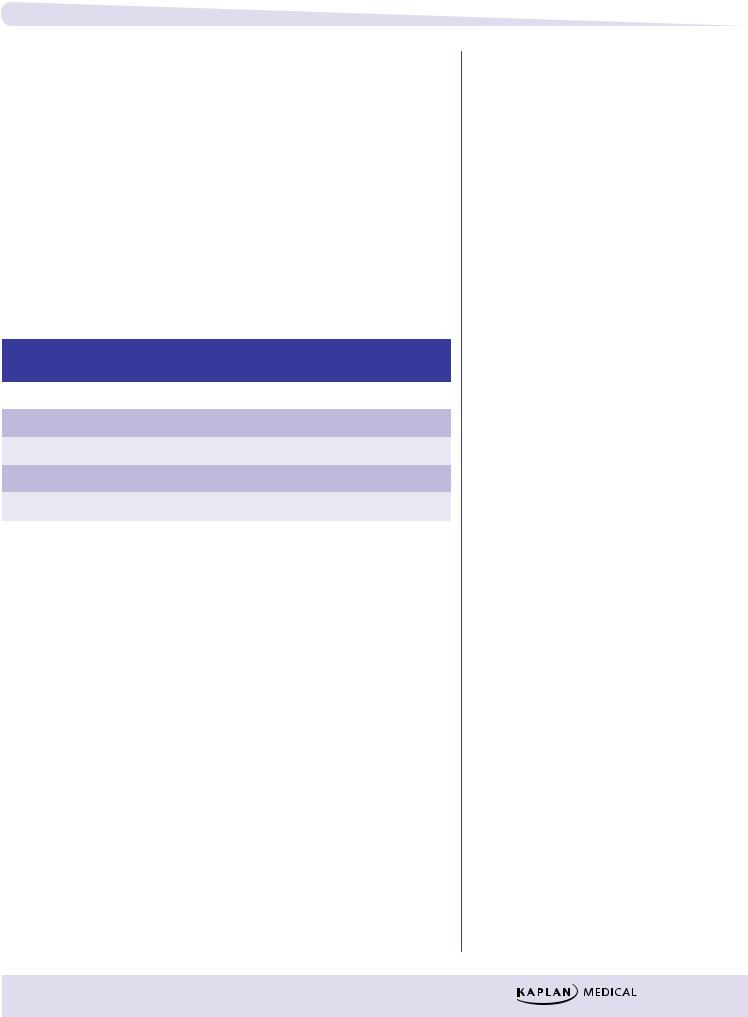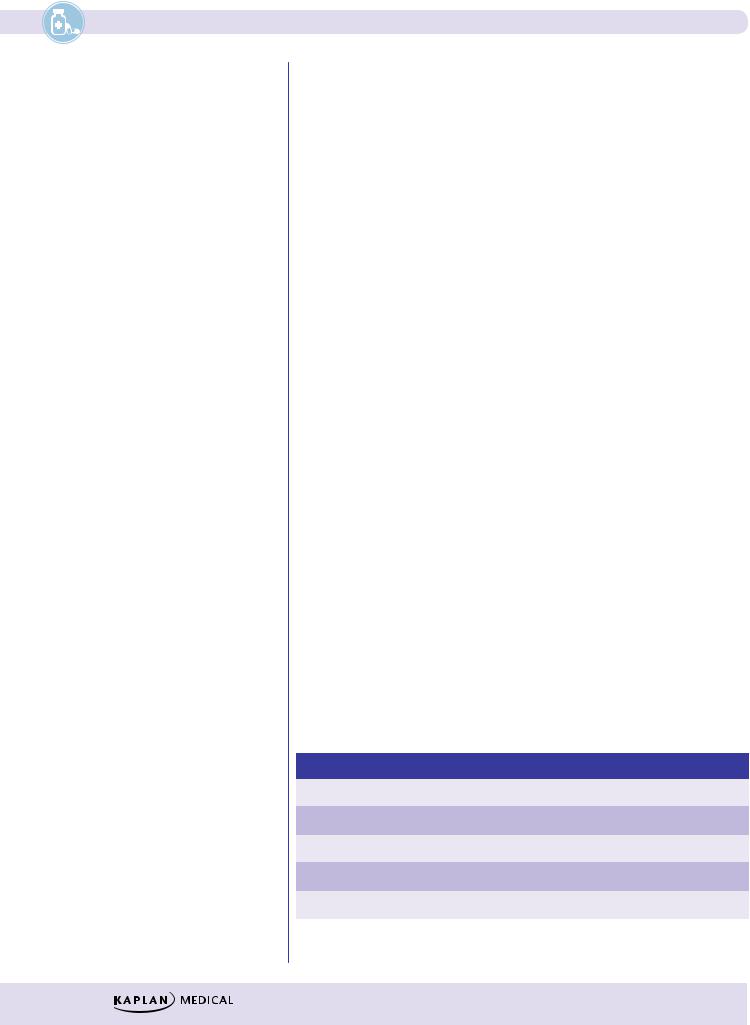
книга / 2016_Kaplan_USMLE_Step_1_Lecture_Notes_Pharmacology
.pdf
Chapter 9 λ CNS Drug List and Practice Questions
6.A patient comes to the ER with a painful stab wound. The ER resident administers pentazocine for the pain. Soon after administration the patient experiences sweating, restlessness, and an increase in pain sensations. What is the most likely explanation for his symptoms?
A.The patient is probably tolerant to pentazocine.
B.The patient is a heroin addict.
C.Pentazocine is an ineffective analgesic.
D.Pentazocine was used at the wrong dose.
E.Pentazocine doesn’t cross the blood-brain barrier.
7.The data shown in the table below concern the effects of drugs on transmitter function in the CNS. Which one of the drugs is most likely to alleviate extrapyramidal dysfunction caused by typical antipsychotics? (The + signs denote intensity of drug actions.)
Drug |
|
Activation of DA |
|
Activation of |
|
Block of ACh M |
|
|
Receptors |
|
GABA Receptors |
|
Receptors |
A. |
++++ |
0 |
0 |
|||
B. |
++ |
++ |
0 |
|||
C. |
0 |
0 |
++++ |
|||
D. |
0 |
+++++ |
0 |
|||
E. |
+ |
+ |
0 |
|||
8.Tricyclic antidepressants
A.have anticonvulsant activity
B.should not be used in patients with glaucoma
C.may increase oral absorption of levodopa
D.are sometimes used as antiarrhythmics
9.Which one of the following statements about lithium is accurate?
A.It causes symptoms of mild hyperthyroidism in up to 25% of patients.
B.Plasma levels are increased by a high-Na diet.
C.Adverse effects include acne, polydipsia, and polyuria.
D.Spina bifida is major concern in fetal development.
E.Sedative actions calm manic patients within 24 h.
169

Section IV λ CNS Pharmacology
10.Ingestion of methanol in wood spirits would cause which of the following to happen?
A.The formation of formaldehyde
B.Nephrotoxicity
C.Hypotension and vomiting
D.The production of glycolic acids
E.Inhibition of aldehyde dehydrogenase
11.What Is the rationale for combining levodopa with carbidopa?
A.Carbidopa stimulates dopamine receptors
B.Carbidopa increases levodopa entry into the CNS by inhibiting peripheral dopa decarboxylase
C.Carbidopa enhances levodopa absorption
D.Carbidopa enhances the peripheral conversion of levodopa to dopamine
E.Carbidopa blocks peripheral COMT
12.A 29-year-old male patient is being treated with an antidepressant drug, and his mood is improving. However, he complains of feeling “jittery” and agitated at times, and if he takes his medication in the afternoon he finds it difficult to get to sleep at night. He seems to have lost weight during the 6 months that he has been taking the drug. He has been warned not to take other drugs without consultation because severe reactions have occurred with opioid analgesics including meperidine. This patient is probably taking
A.alprazolam
B.chlorpromazine
C.paroxetine
D.amitriptyline
E.trazodone
13.The ability of several drugs to inhibit the reuptake of CNS amine neurotransmitters is shown in the table below (number of arrows ↓ indicates the intensity of inhibitory actions). Which one of the drugs is most likely to have therapeutic effectiveness in the management of both obsessive-compulsive disorders (OCD) and major depressive disorders?
Drug |
|
DA Reuptake |
|
NE Reuptake |
|
5HT Reuptake |
|
GABA Reuptake |
A. |
↓↓ |
0 |
0 |
↓↓ |
||||
B. |
0 |
|
↓↓↓↓ |
|
↓ |
0 |
||
C. |
0 |
0 |
|
↓↓↓↓ |
0 |
|||
D. |
0 |
0 |
|
↓ |
|
↓↓↓↓ |
||
E. |
↓↓↓↓ |
↓↓ |
0 |
0 |
||||
170

Chapter 9 λ CNS Drug List and Practice Questions
14.A patient suffering from attention deficit hyperactivity disorder is placed on atomoxetine. A drug that has a similar mechansim of action to atomoxetine is
A.methylphenidate
B.botulinum toxin
C.clonidine
D.amitriptyline
E.entacapone
15.A patient suffering from generalized anxiety disorder (GAD) has a history of drug dependence that includes the illicit use of secobarbital (“reds”) and a variety of other drugs. Psychotherapy is indicated, but the physician also prescribes a drug that can be helpful in GAD and that has the advantage of no abuse liability. The drug prescribed was most likely to have been
A.bupropion
B.buspirone
C.baclofen
D.buprenorphine
E.phenobarbital
16.A patient has been diagnosed has having “long QT syndrome.” The patient is experiencing significant pain following a bout with shingles. What would be an appropriate drug for his pain?
A.Amitriptyline
B.Fentanyl
C.Acyclovir
D.Diazepam
E.Gabapentin
17.A habitual user of a schedule-controlled drug abruptly stops using it. Within 8 h, she becomes anxious, starts to sweat, and gets severe abdominal pain with diarrhea. These symptoms intensify over the next 12 h, during which time she has a runny nose, is lacrimating, and has uncontrollable yawning and intensification of muscle cramping and jerking. Assuming that these are withdrawal symptoms in the patient due to her physical dependence, the drug most likely to be involved is
A.alprazolam
B.amphetamine
C.ethanol
D.meperidine
E.secobarbital
171

Section IV λ CNS Pharmacology
18.A 57-year-old patient, living at home, has severe pain due to a metastatic carcinoma that is being managed with fentanyl, delivered transdermally from a patch. He should also be taking, or at least have on hand
A.apomorphine
B.docusate
C.loperamide
D.morphine
E.naloxone
19.A hospital nurse is taking imipramine for a phobic anxiety disorder, and her patient is being treated with chlorpromazine for a psychotic disorder. Which of the following adverse effects is likely to occur in both of these individuals?
A.Excessive salivation
B.Pupillary constriction
C.Orthostatic hypotension
D.Seizure threshold
E.Weight loss
20.Which one of the following pairs of “drug/mechanism of action” is most accurate?
A.Carbamazepine/facilitation of the actions of GABA
B.Ethosuximide/blocks Na channels in axonal membranes
C.Phenelzine/inhibits dopa decarboxylase
D.Procaine/blocks Ca channels (type T) in thalamic neurons
E.Lithium/inhibits recycling of inositol
21.A 30-year-old male patient is brought to the ER with the following symptoms attributed to a drug overdose: HR and BP, mydriasis, behavioral excitation, aggressiveness, paranoia, and hallucinations. Of the following drugs, which one is most likely to be responsible for these symptoms?
A.Amphetamine
B.Ethanol
C.Fentanyl
D.Flunitrazepam
E.Marijuana
22.Which one of the following CNS receptors is directly coupled to an ion channel so that the effects of its activation do not involve second messenger systems?
A.N (ACh)
B.α (NE)
C.D2A (DA)
D.µ (beta endorphin)
E.5HT2 (serotonin)
172

Chapter 9 λ CNS Drug List and Practice Questions
Answers
1.Answer: C. Most benzodiazepines are metabolized by liver cytochrome P450. In a patient lacking liver function, benzodiazepines that are metabolized via extrahepatic conjugation (e.g., lorazepam, oxazepam) are safer in terms of the possibility of excessive CNS depression. Lorazepam is metabolized, probably in the lungs, via glucuronidation. Although benzodiazepine actions can be reversed, the drug that acts as an antagonist is flumazenil, not naloxone.
2.Answer: E. Benzodiazepines interact with components of the GABA recep- tor–chloride ion channel macromolecular complex. Binding of BZs leads to an increase in the frequency of chloride ion channel opening elicited by the
inhibitory transmitter GABA. Benzodiazepines do not act on GABAB receptors; baclofen, a centrally acting muscle relaxant, is an agonist at these receptors. Buspirone, the selective anxiolytic, may be a partial agonist at 5HT receptors.
3.Answer: C. Morphine continues to be used in pulmonary congestion, in part because of its sedative (calming) and analgesic effects and also because of its vasodilating actions, which result in favorable hemodynamics in terms of cardiac and pulmonary function. Similarly, morphine is of value in an acute MI, especially its ability to relieve pain. However, morphine is not suitable for pain of biliary origin because it causes contraction of the sphincters of Oddi, leading to spasms. None of the other proposed indications are appropriate.
4.Answer: C. Benzodiazepines, barbiturates, and ethanol all modulate the actions
of the GABAA receptor, while baclofen works at the GABAB receptor, and dronabinol works on cannabinoid receptors. Of the GABAA drugs, only barbiturates have GABA-mimicking activity and this occurs at high doses. This is one of the reasons why barbiturates are a more dangerous group of drugs than benzodiazepines since benzos lack GABA-mimicking activity.
5.Answer: E. Phenytoin has the unusual characteristic of following first-order elimination kinetics at low doses but zero-order kinetics at high doses because of saturation of the liver enzymes involved in its metabolism. Carbamazepine, like most drugs, follows first-order kinetics. Both drugs are P450 inducers and can increase the metabolsim of oral contraceptives making them less effective. Both drugs are teratogenic, causing structural abnormalities during fetal development including cleft palate. Both drugs block inactivated sodium channels, preventing sodium entry, thereby prolonging the time to recovery.
6.Answer: B. Pentazocine is an agonist at κ (kappa) opioid receptors and an antagonist at µ opioid receptors. Mixed agonist-antagonists can displace µ receptor agonists such as heroin from receptors, resulting in the rapid development of symptoms of withdrawal in patients who are physically dependent on such drugs—“precipitated withdrawal.” Symptoms include yawning, lacrimation, salivation, restlessness, anxiety, sweating, goosebumps, muscle cramps, and pain.
7.Answer:C.Muscarinicreceptorantagonistssuchasbenztropine,trihexy-phenidyl, and diphenhydramine are used to manage the reversible extrapyramidal dysfunction (e.g., pseudo-Parkinsonism) that results from treatment with drugs that block DA receptors in the striatum (typical antipsychotics). Drugs that activate DA receptors, although theoretically possible, require doses that are toxic and exacerbate psychoses. Because the actions of DA in the striatum lead to inhibition of GABA-ergic neurons, drugs that activate GABA receptors are unlikely to be effective in this situation, although they may well have both anxiolytic and anticonvulsant properties.
173

Section IV λ CNS Pharmacology
8.Answer: B. In addition to blocking reuptake of NE and 5HT, pharmacodynamic actions of the tricyclic antidepressants include block of peripheral adrenergic and muscarinic receptors—the former resulting in postural hypotension and the latter, via mydriasis, exacerbating glaucoma. TCAs may cause arrhythmias in overdose. They have no effect on the absorption of levodopa.
9.Answer: C. Lithium causes goiter in a significant number of patients; however, thyroid dysfunction does not occur in all such patients, and when it does it presents as hypothyroidism (not hyper-T). High-Na diets increase lithium elimination; low Na increases lithium plasma levels. Uncoupling of vasopressin receptors is characteristic of lithium, leading to a nephrogenic diabetes insipidus. Although potential teratogenicity is a concern during pregnancy, lithium does not cause neural tube defects but may cause abnormalities in heart valves. Lithium takes 10 to 20 days for effectiveness, and in acute mania it is often necessary to calm the patient with parenteral antipsychotic drugs such as fluphenazine or haloperidol.
10.Answer: A. Methanol is metabolized by alcohol dehydrogenase to formaldehyde and then further metabolized to formic acid by aldehyde dehydrogenase. Its major toxicity is severe vision damage. Ethylene glycol Ingestion is associated with nephrotoxicity, while ethanol ingestion causes nausea, vomiting, and hypotension.
11.Answer: B. Carbidopa inhibits peripheral dopa decarboxylase which enhances uptake of levodopa into the CNS and therefore, its conversion to dopamine. Carbidopa doesn’t cross the blood-brain barrier and therefore has no direct benefit at dopamine receptors.
12.Answer: C. The patient is probably taking an SSRI such as paroxetine. SSRIs rarely cause sedation and commonly cause agitation and the “jitters,” which sometimes necessitates concomitant use of drugs that are strongly sedating, such as trazodone. SSRIs are best taken in the morning to avoid problems of insomnia, and they appear to cause weight loss, at least during the first 12 months of treatment. Severe drug interactions leading to the “serotonin syndrome” have been reported when SSRIs have been used together with MAO inhibitors, tricyclics, and the opioid meperidine.
13.Answer: C. Drug C appears to be a selective inhibitor of the reuptake of serotonin, and existing drugs of this class (SSRIs) are approved for use in both major depressive and obsessive-compulsive disorders. The tricyclic antidepressant clomipramine, a potent inhibitor of 5HT reuptake, was formerly the drug of choice for OCD until replaced by the SSRIs. Drugs A and E may have value in the treatment of Parkinson disease because they block the reuptake of DA. Drug D may be effective in anxiety and seizure states because it is an effective blocker of GABA reuptake.
14.Answer: D. Atomoxetine is used in attention deficit hyperactivity disorder (ADHD) and works by blocking the reuptake of norepinephrine into nerve terminals. This mechanism is how both cocaine and the tricyclic antidepressants such as amitriptyline work. Amphetamines such as methylphenidate are also commonly used in ADHD and work by displacing norepinephrine from the mobile pool.
174

Chapter 9 λ CNS Drug List and Practice Questions
15.Answer: B. Buspirone has selective anxiolytic activity that is slow in onset. The drug has no abuse liability and will not suppress withdrawal symptoms in patients who have become physically dependent on barbiturates, benzodiazepines, or ethanol. Bupropion is an antidepressant, also approved for management of dependence on nicotine. Baclofen is a spinal cord muscle relaxant that
activates GABAB receptors. Buprenorphine is a long-acting opioid analgesic with no effectiveness in GAD, and phenobarbital is a barbiturate that may cause dependence.
16.Answer: E. The patient is experiencing postherpetic neuralgia. While acyclovir is effective at eradicating the herpes virus it is ineffective against the pain of shingles. Appropriate drugs are TCAs like amitriptyline and gabapentin. Patients with long QT syndrome have a genetic flaw in cardiac inward rectifying K current, leading to increased APD. Drugs that accentuate this by inhibiting the repolarizing K current (phase 3), which include thioridazine and the tricyclic antidepressants, are likely to have enhanced cardiotoxic potential in such patients. As a result, this patient should be placed on gabapentin.
17.Answer: D. The signs and symptoms described are typical of withdrawal from physical dependency on an opioid that has efficacy equivalent to a full ago- nist—in this case, meperidine. Although anxiety, agitation, and even muscle jerking may occur in withdrawal from dependence on sedative-hypnotics such as alprazolam and secobarbital, the symptoms of GI distress, rhinorrhea, lacrimation, and yawning are not characteristic (seizures are more typical). Symptoms of withdrawal from high-dose use of CNS stimulants such as amphetamine or cocaine include lassitude and severe depression of mood. The phrase “schedule-controlled” refers to FDA classifications of drugs that have abuse liability, including both licit and illicit drugs.
18.Answer: B. Fentanyl is a full agonist at opioid receptors and provides analgesia in cancer pain equivalent to morphine, so there is no good reason to have morphine on hand, and it would be a danger to the patient in terms of accidental overdose. Apomorphine is an emetic, hardly appropriate given the stimulatory effects of opioids on the emetic center. Likewise, loperamide is used in diarrheal states, and patients on strong opioids are almost certain to be constipated; for this reason, a stool softener like docusate should be available to the patient. The opioid antagonist naloxone is used IV in overdose situations but would not be provided to the patient for use PRN.
19.Answer: C. Orthostatic hypotension occurs with both tricyclic antidepressants and phenothiazines because both types of drug can block alpha-adrenergic receptors in venous beds. Their ability to block M receptors leads to xerostomia (not salivation) and mydriasis (not miosis). Tricyclics and phenothiazines also share a common tendency to decrease seizure threshold and cause weight gain (not loss).
20.Answer: E. Lithium inhibits the dephosphorylation of IP2 (needed for the recycling of inositol), leading to depletion of membrane PIP2. Consequently, the activation of receptors by neurotransmitters such as ACh, NE, and 5HT fails
to release the second messengers IP3 and DAG. Carbamazepine and the local anesthetic procaine block axonal Na channels; ethosuximide may block Ca channels in thalamic neurons. Phenelzine is a nonselective inhibitor of MAO.
175

Section IV λ CNS Pharmacology
21.Answer: A. The signs and symptoms are characteristic of a CNS stimulant that facilitates the activity of amines in both the CNS and the periphery. Amphetamines promote the release of NE from sympathetic nerve endings, causing CV stimulation and pupillary dilation. In the CNS, they enhance the actions of DA, NE, and 5HT, causing behavioral excitation and a psychotic state that may be difficult to distinguish from schizophrenia. Ethanol, marijuana, fentanyl, and flunitrazepam (a benzodiazepine that has been used in “date rape”) are all CNS depressants.
22.Answer: A. ACh receptors in the CNS are present on less than 5% of the neu-
ronal population. Most of them are of the muscarinic subtype, M1 (excitatory) and M2 (inhibitory), via G-protein coupled changes in cAMP. Nicotinic receptors are excitatory via direct coupling to cation channels (Na/K), and their activation does not initiate second messenger pathways. Other CNS transmitter receptors that are directly coupled to ion channels include those for GABA and glutamic acid. Almost all CNS receptors for DA, NE, 5HT, and opioid peptides are coupled to ion channels via second messenger systems.
176

SECTION V
Antimicrobial
Agents
